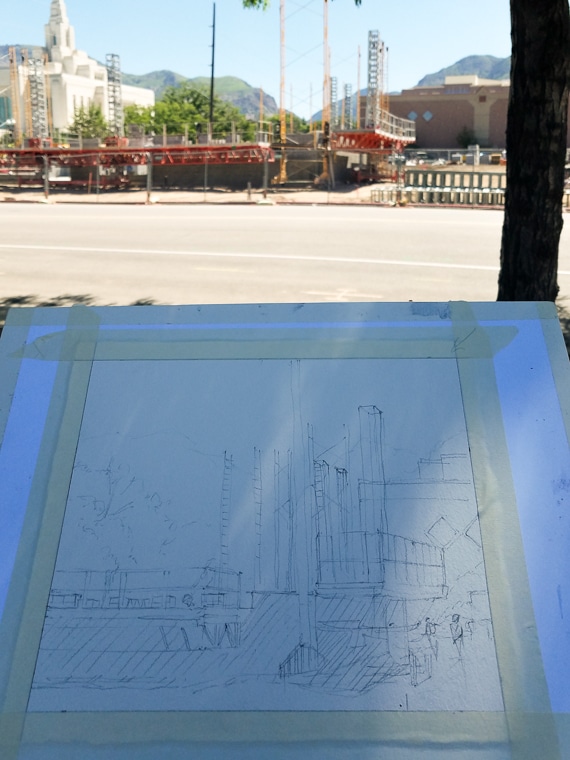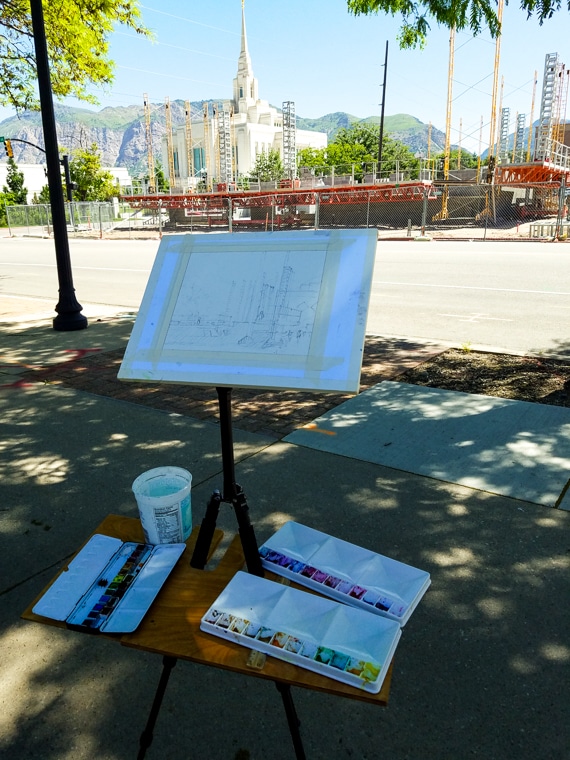
Definition
The term “en plein air”, or plein air painting comes from the French phrase “in open air” or painting outside. It is more familiar now, but was a new concept in the late 1800’s when the Impressionist would go out of their studios to paint outside.
Environment / locations / weather
When painting plein air you are outside, whether on the sidewalks of a busy city, in a quiet park, or even your own backyard.
Being out in and uncontrolled environment adds a new challenge to your painting. You must be more aware of your surroundings, is it hot or cold (which affects your paints), finding a place to paint where there is shade so you don’t over heat, and there are usually lots of bugs that love you be a part of your painting as well.

Feelings / emotions
Your feelings and emotions play the biggest part in painting plein air.
Because painting plein air is more about capturing a moment or a feeling while you are outside, you need to be quick to capture that moment. And not be so worried about the technical side and accuracy of making it look exactly like what you see as you would in the studio.
You need to work more quickly because the light and shadows change drastically when outside.
Pros / cons
Pros:
- You can be outside to see and observe your subject first hand
- Painting what your subject made you feel in that moment
- You have people who stop to see what you are doing and it can lead to potential customers. (have business cards and a notebook handy)
- Being outside
Cons:
- Weather, battling heat, cold, wind, sudden rain showers (it’s an adventure!)
- Bugs crawling on you and your painting
- Too many people stopping to talk to you about what your painting and you’re not able to paint
- Time, you need to paint more quickly because your environment is constantly changing
- View blocked by vehicles or others
Supplies
I will give you a list of supplies you need to get started for painting plein air with watercolor.
- Portable easel
(not always necessary as you can use a pad)
- Paper
- Paints
– I recommend the godets which are like cakes or pan paint. They are easier for traveling since the paint is dry and you rewet the paint. The paints are specially made for this purpose and will not be less powerful or diluted. Also, they will not mildew.
- Palette for mixing paints (using the pans / godets holder)
- Water (drinking and painting) – Platypus
water bottles are the best, they roll up and store nicely when empty.
- Brushes, pencils, erasers – I have some amazing travel brushes
that I will leave a link to, they come in varied sizes and are protected from being damaged.
- Backpack
to put it all in – I found a back pack that is square on top which helps so much when transporting paper, since it doesn’t dog ear it.

Competitions
Look for local plein air competitions, I bet there are plenty in your area or not far from you.
From my experience, when entering you pay a fee and have your canvas /paper stamped. This is to ensure you are painting outside and not using a painting done before. The competition organizers will give you boundaries and an outline of what is acceptable. No studio time is allowed. Your painting needs to be started and completed within the boundaries and in a set amount of time. When done your painting needs to be framed and matted when turned in for the judging.
Rebuilding Our History won 2nd place in the 2018 Ogden Plein Air Competition. Also Reflected Union won 2nd place in the 2017 Ogden Plein Air Competition.
Competitive artists:
Here are two amazing plein air artists that travel the country painting at Festivals and Competitions. Both have won many awards and continue to inspire those they meet. Alison (Alison Menke Facebook) is an inspiration as she captures the beauty of very diverse landscapes travelling throughout the country. I was privileged to meet Beth Bath at a local plein air competition, she was very open and gave me encouragement on my work. I love and enjoy Beth’s style and approach to plein air you can discover her work on her website.

Conclusion
Plein air means painting outside. It is mostly about capturing what you feel in a moment and putting it on paper rather than creating a perfect masterpiece. I also shared with you some of my supplies to help you start plein air painting, and some tips to make you successful at your plein air competitions.
What are some tips and tricks you want to learn for plein air painting that I didn’t mention in this post?
Answer in the comment section below.

